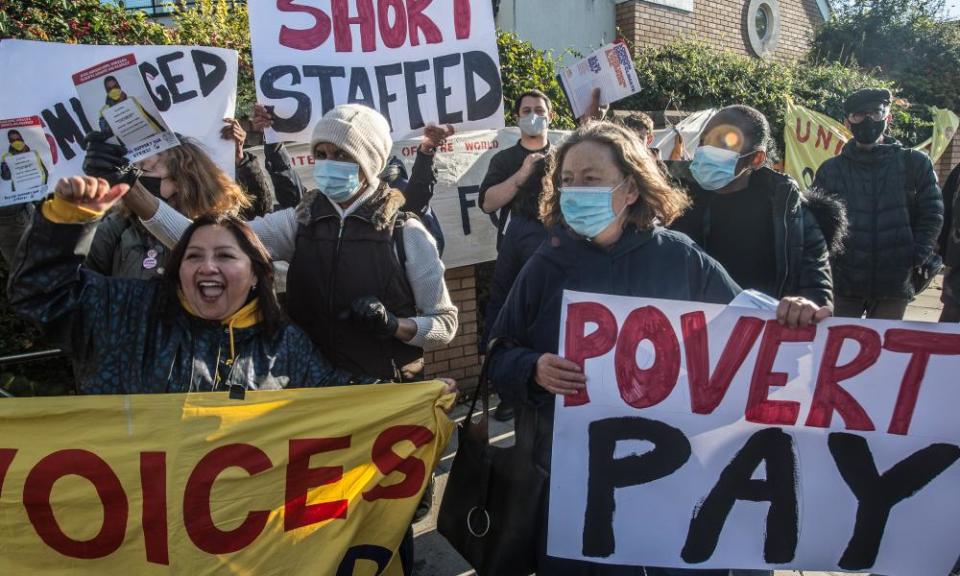This isn’t a plan for social care in England – it’s a recipe for disaster

After all this time, is that it? The white paper on social care in England, published on Wednesday, doesn’t begin “to fix social care once and for all”, as Boris Johnson promised on Downing Street’s steps. Ignoring the scale of this crisis, nothing was announced that will actually slow the galloping rate of the sector’s collapse, with half of councils having dealt with a care home closure or bankruptcy in the past six months.
Only a fifth of funds, £1.7bn, raised from the new national insurance levy goes where it’s most needed, including retaining a vanishing social care workforce, which is already 100,000 short. Instead, the bulk of the £5.4bn will go on preserving the inheritances of well-off homeowners. Wednesday’s announcement, which does not come with extra money, reallocates some to new technology for collecting data, assessing risks to help prevent patient falls and for adapted housing for the frail. But in this hurricane, good ideas risk sinking under water.
What an odd political blunder, not to “level up” in class and geography but instead perversely tip the scales towards the richer south. The design of the £86,000 cap on care costs means Boris Johnson’s promise that no one will lose their home to pay for care is kept only for southerners with expensive properties, not for northerners whose house prices are lower, contrary to his electoral strategy.
Here are the bleak financial facts: social care funding will only return to the level it was at 15 years ago by 2025, Ben Zaranko, senior research economist at the Institute for Fiscal Studies, tells me. In fact it’s worse than that: the population has grown since then and so has the number of elderly people who need help, so per capita funding will still fall far below the standards of 2010, which were never brilliant.
Related: Jeremy Hunt and Labour attack ministers’ social care plan
Here’s the scale of the crisis: Age UK’s charity director, Caroline Abrahams, says the number of people now receiving no care who would have qualified a decade ago has risen to 1.6 million in England, leaving many vulnerable people home alone with neither family nor care. Social service directors this week reported that a further 400,000 people are stuck is a queue waiting to be assigned the care they qualify for. No one yet knows the significance of a 30% rise in numbers of people dying at home over the past two years, but some of these will be the lonely, unattended deaths of those denied care. The number of district nurses has been cut by half in eight years.
Care staff are leaving the sector to work in warehouses, supermarkets or the NHS, where the pay is better. If they were to be paid the same as the lowest band for NHS healthcare assistants, the cost would be an extra £1.2bn a year, says the IFS – but that’s much more than what is in this care plan. Why are care workers paid so much less than NHS staff with the same skills? Because they are virtually un-unionised, they have no pay review body, no national pay scale and they are scattered among a host of small employers. Without muscle, there’s no leverage for a pay and career regime to attract and retain this disappearing workforce.
Besides, care is not just for the old. Half that puny £1.7bn must cover care for people of working age, with the number of those with disabilities surviving birth and childhood who might not have generations ago growing.
One of the most perverse policies will actually accelerate care home collapse. At the moment, many providers keep going by cross-subsidising their underfunded council residents through charging the self-payers about 40% extra. The government says that’s unfair, so self-payers will be allowed to ask their council to fix their care at the lower rate. That’s a recipe for instant bankruptcy.
As council fees are so low, if everyone were to pay that rate, a lot of homes would go under at a stroke, says Mike Padgham, head of the Independent Care Group, an umbrella lobby for small northern care home owners. No wonder Stephen Chandler, president of the Association of Directors of Adult Social Services, warned this week: “Red lights are flashing right across our dashboard.” His organisation calls for a £1,000 winter retention bonus to keep hold of care staff. Jeremy Hunt’s health and social care select committee estimates that £7bn is needed to keep social care afloat.
The Treasury may reckon most voters will never see these private care tragedies hidden behind lace curtains, with only a few families using care at any one time. The hot politics are all with the NHS, and especially its ballooning waiting lists. But any attempt to clear that backlog of operations will fail with too many hospital beds filling up with those denied social care. This derelict plan leaves health and social care even less prepared for a future pandemic wave.
Polly Toynbee is a Guardian columnist

 Yahoo Finance
Yahoo Finance 